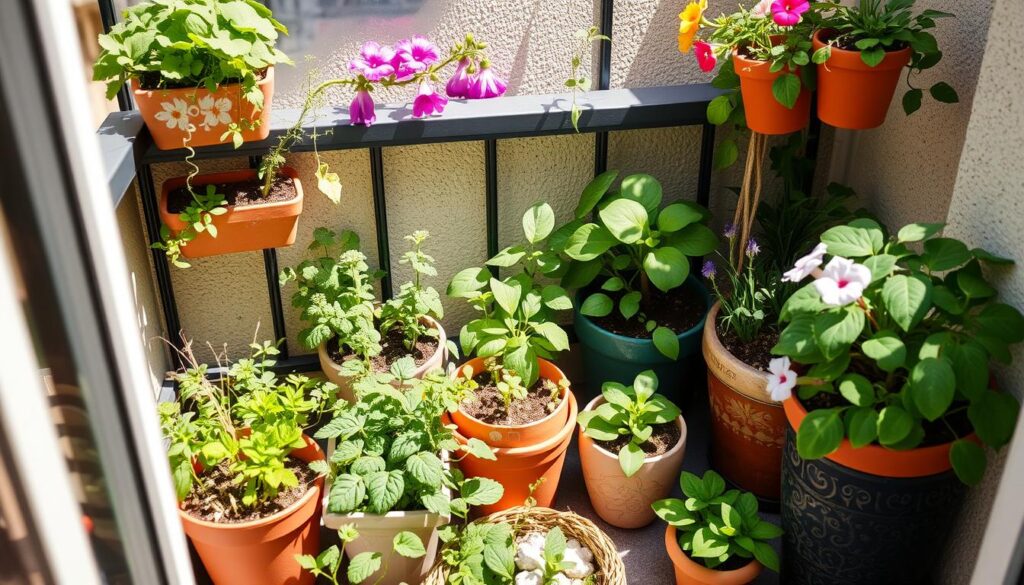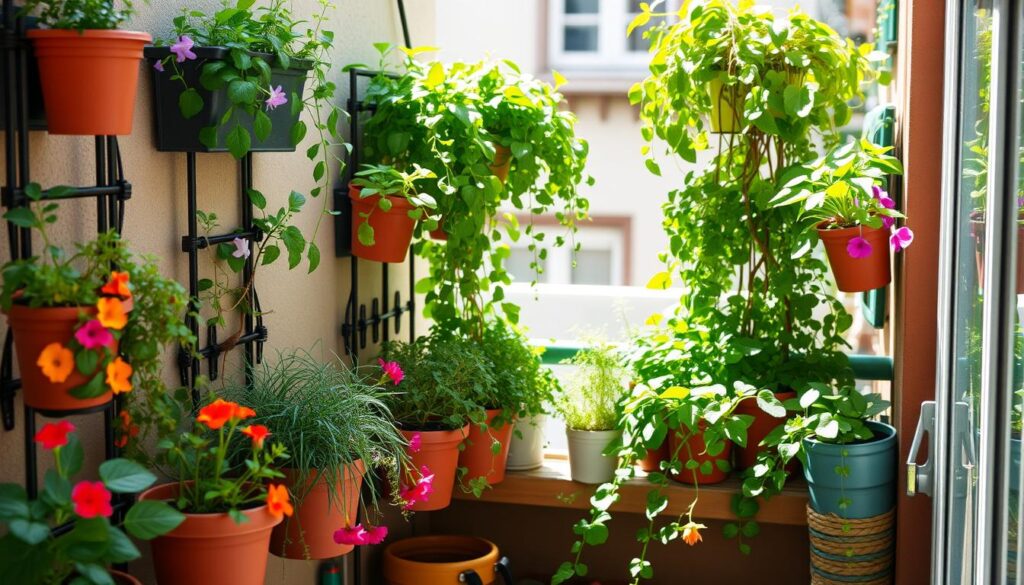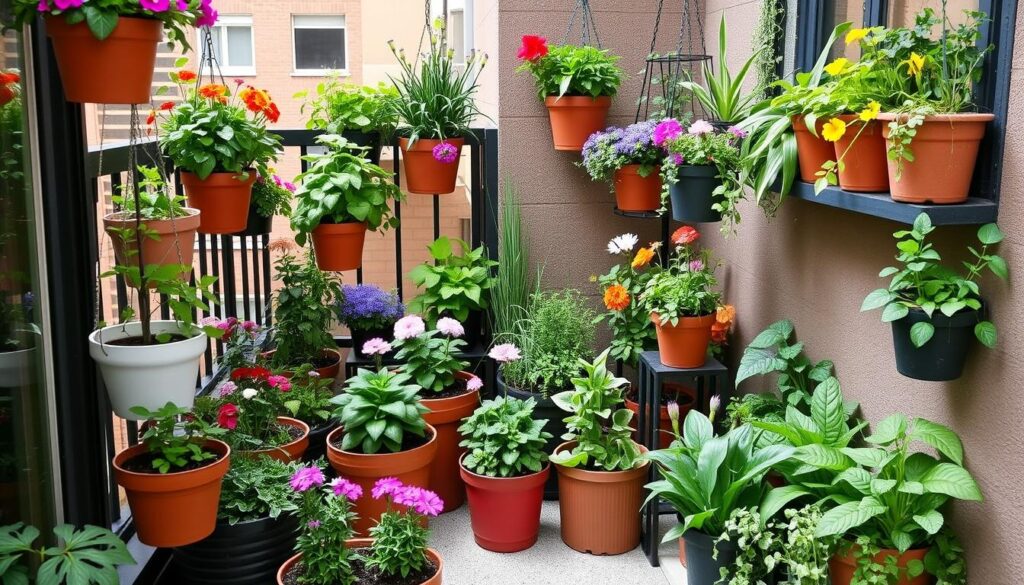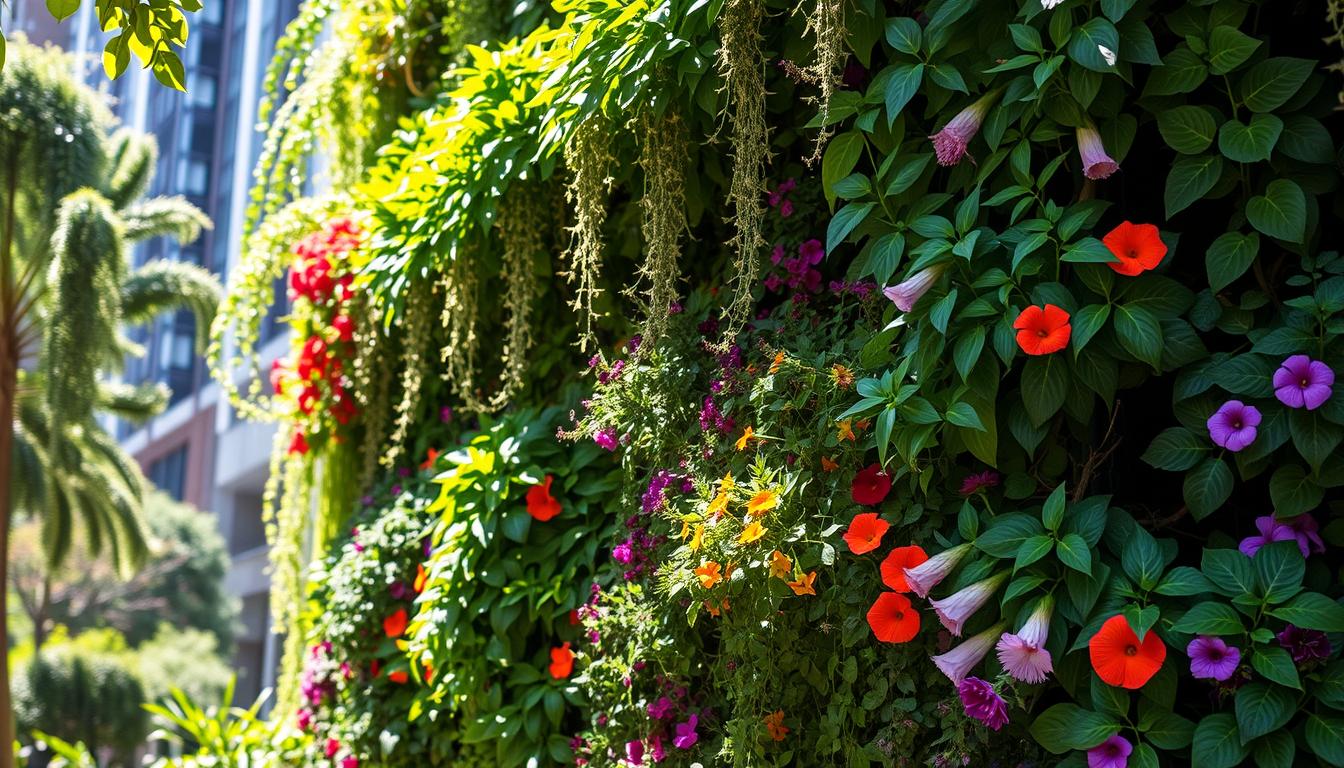Micro-gardens are perfect for small spaces. They let you grow plants like veggies, herbs, and flowers. Even tiny areas like balconies or rooftops can be used for gardening.

Even with little sunlight, you can have a thriving garden. Some plants do well in shade. You can also grow plants up using trellises, making the most of your space.
Key Takeaways
- Micro-gardens for tiny spaces can be created in small areas such as balconies, patios, or rooftops.
- Small space gardening can be used to grow a variety of plants, including vegetables, herbs, and flowers.
- Vertical gardening techniques can increase yield in small spaces by utilizing trellises and supports.
- Compact garden design and square inch gardening can help maximize every square inch of available space.
- Urban micro-gardens can thrive in small spaces with limited sunlight by using shade-tolerant plants.
- Tiny garden ideas can be used to create a beautiful and functional outdoor area, even in the smallest of spaces.
- Micro-gardens can increase the perceived area of a space by up to 20% when properly designed.
Understanding the Basics of Micro-Gardens for Tiny Spaces
Micro-gardens are great for city living. They let people do space-efficient gardening in small spots. Using vertical gardening techniques, you can turn tiny areas into lush gardens.
Creating a micro-garden offers many benefits. It lets you grow many plants in small areas. This way, you can use every bit of your outdoor space to grow more.
- Containers that are at least 12 inches deep for healthy roots
- A good watering system to keep plants moist
- Plants that do well in small spaces, like annuals, perennials, and shrubs
Learning the basics of micro-gardens helps you make the most of small spaces. You can have a productive garden, no matter how small your area is.
| Plant Type | Container Size | Space Requirements |
|---|---|---|
| Annuals | 4-6 inches | Full sun to semi-shade |
| Perennials | 10-12 inches | Full sun to full shade |
| Shrubs | 16-20 inches | Full sun to semi-shade |
Space-Saving Vertical Gardening Techniques
Vertical gardening is a smart way to use small spaces. It uses trellises, arbors, and wall-mounted planters to grow plants upwards. This makes it easy to have a compact garden in tiny areas, perfect for small space vegetable gardening.
Techniques like terracing, trellising, and tumbling are great for compact gardening. Terracing creates levels on sloped hillsides. Trellising trains plants to grow up, great for cucumbers, peas, and tomatoes. Tumbling uses hanging planters for plants like strawberries and cherry tomatoes.
These space-saving gardening methods can turn even the smallest areas into a lush garden. Wall-mounted planters and trellises help use every inch. Popular tools include the TopsyTurvy Tomato Planter and hanging planters for herbs, cherry tomatoes, and more.

Using these space-saving gardening techniques boosts your yield and uses space wisely. Whether you want a small herb garden or a big vegetable garden, compact gardening can help. With some creativity and planning, you can create a beautiful outdoor space that’s both functional and space-efficient.
| Technique | Description | Benefits |
|---|---|---|
| Terracing | Creating multiple levels of planting space | Maximizes space, improves drainage |
| Trellising | Using a trellis or other support to train plants to grow upwards | Increases yield, reduces space requirements |
| Tumbling | Using hanging planters to grow plants that naturally trail or spill over | Maximizes space, adds visual interest |
Smart Container Solutions and Plant Selection
Maximizing small spaces is key for a thriving micro-garden. Using smart containers and picking the right plants is crucial. With the right choices, you can have a beautiful and productive garden, even in tiny spaces.
For small space garden design, think about using self-watering containers or ones with good drainage. This ensures your plants get the right water and nutrients. It’s vital for space-saving gardening tips, helping you make the most of small spaces without harming your plants.
Choosing the Right Containers
When picking containers, think about size and material. For example, a 5-gallon container is great for tomatoes, while a 2-gallon is better for herbs and leafy greens. Choosing the right containers helps you make the most of your space and grow a thriving small space garden.

Best Plants for Limited Spaces
Some top plants for small spaces include dwarf varieties of veggies and herbs. Think of dwarf fruit trees and compact berry bushes. These plants are made for small spaces and do well in containers. They’re perfect for small gardens, helping you grow a variety of plants in even the smallest areas.
Creative Design Strategies for Maximizing Every Square Inch
In compact gardening, every inch is crucial. Techniques like raised beds and vertical gardening make your outdoor space beautiful and useful. Tips for urban gardening, such as using light colors and mirrors, can make your space seem bigger.
Creating a compact garden involves smart layouts. Ideas like built-in seating and multi-use furniture make your space cozy. Solutions like vertical storage and hidden spots keep your garden tidy and organized.
Here are some ways to make the most of your space:
- Use raised beds to expand your usable area
- Add decorative items like sculptures and water features
- Try vertical gardening to add up to 30% more space
- Use mirrors to make your space look deeper
With these creative strategies, you can have a beautiful and practical compact garden. It will meet your needs and improve your outdoor time. Even the smallest space can become a lush oasis with the right techniques and tips.
Conclusion: Embracing the Potential of Your Tiny Garden Space
Micro-gardens open up a world of possibilities, even in the smallest spaces. By using vertical gardening, smart containers, and creative designs, you can turn your balcony, patio, or rooftop into a lush oasis. These gardens not only make your outdoor space look better but also improve the air and save on energy costs.
Whether you live in the city, have limited space, or love gardening, making the most of your tiny garden can be very rewarding. Choose plants that don’t need much water and use an efficient watering system. Regular care will make your micro-garden beautiful and sustainable all year.
Vertical gardening is becoming more popular, boosting your property’s value by up to 30% with better outdoor looks. So, begin your journey to a vibrant, space-saving micro-garden. It will inspire and refresh you every day.
FAQ
What is a micro-garden?
A micro-garden is a small garden in a tiny space like a balcony or rooftop. You can grow veggies, herbs, and flowers in these small areas.
What are the benefits of small space gardening?
Small space gardening lets you grow many plants in a small area. It uses vertical gardening to save space. It also makes a beautiful outdoor area, even in tiny spaces.
What essential tools and materials are needed to create a micro-garden?
To start a micro-garden, you need containers, soil, and a watering system. Pick containers that are self-watering and drain well for your garden’s success.
How can vertical gardening techniques be used in a micro-garden?
Vertical gardening uses trellises and wall planters to grow plants up. This saves space in a micro-garden. It’s great for growing many types of plants.
What are some smart container solutions for a micro-garden?
Smart containers for a micro-garden include self-watering and well-draining options. Choose containers that fit your plants’ needs for water and nutrients.
What types of plants are best suited for a micro-garden?
For a micro-garden, pick plants that grow well in small spaces. Look for dwarf or compact varieties of veggies and herbs.
How can I incorporate creative design strategies into my micro-garden?
Use raised beds and create a focal point in your micro-garden. Add decorative elements like sculptures or water features. These strategies make the most of your small space.
Source Links
- Small Space Gardening Ideas: Tips For Small Garden Spaces
- 15 Tips for Gardening in Small Spaces
- Landscape Design Techniques for Small Spaces
- How to design a small urban garden in six steps
- How to Grow Fruit & Vegetables in Small Spaces: Complete Guide – Urban Turnip
- 15 Tips For Vegetable Gardening in Small Spaces
- Tips for the Square-Inch Gardener: Vertical Gardening | Chelsea Green Publishing
- Maximize Small Spaces: Vertical Gardening Techniques
- Planting Vegetables With Limited Space
- 10 Smart Ways to Maximize Small Space Garden Yields – FarmstandApp
- 10 Genius Urban Gardening Hacks for Small-Space Abundance – Bluestem Gardening
- 11 Ideas on How to Maximize a Small Outdoor Patio
- 31 Small-Space Solutions for Every Room in Your Home
- Maximizing Small and Enclosed Patio Spaces: A Comprehensive Guide
- Vertical Gardening: Maximize Space and Add Visual Appeal
- Maximize Your Space: A Beginner’s Guide to a Compact Cut Flower Garden – Bootstrap Farmer
- Indoor Garden Ideas: Innovative Solutions for Year-Round Growing




